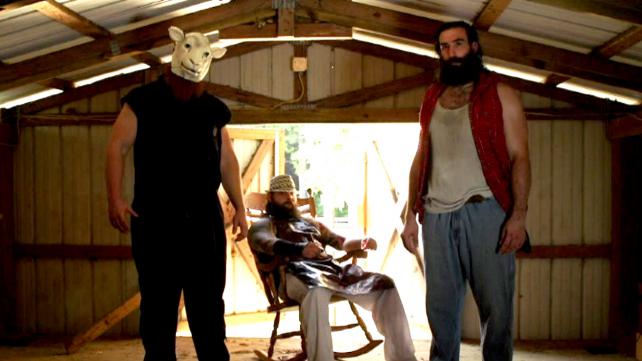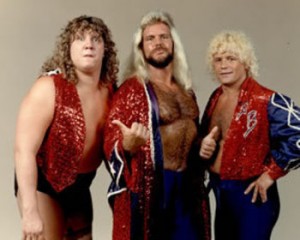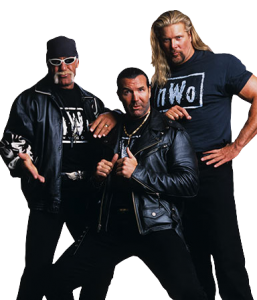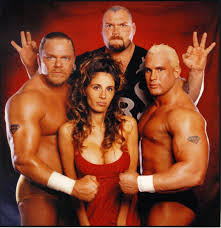 The Shield and the Wyatt Family are recent examples of the long tradition of trios in pro wrestling.
The Shield and the Wyatt Family are recent examples of the long tradition of trios in pro wrestling.
On Raw two weeks ago, after more than a month of vignettes and even more months of internet speculation, Bray Wyatt debuted in the WWE to a rabid response. Preaching a cult-like prophecy under the guise of a Cajun-spiced backwoods wardrobe, Wyatt has generated a lot of good buzz coming out of the NXT developmental scene. But just as he declared in the previous weeks, he was not alone. He also brought along with him two tall members of his self-professed family in Luke Harper and Erich Rowan. As Wyatt marched under a lone spotlight with a lamp in hand in one of the more creative entrances the WWE has concocted in the last few years, Harper and Rowan, both sporting grizzly beards and one wearing a goat mask, were right there with him to do the dirty work. In his debut segment, Wyatt did not even go into the ring as Harper and Rowan wildly took out Kane for their leader. R-Truth was next a week later, this time with Wyatt setting the example by showing some of the in-ring prowess people caught a glimpse of when he originally debuted in the WWE as up-and-coming Husky Harris. Wyatt’s trademark battle cry has become, “Down with the machine,” but the irony is that the success of the Wyatt Family is a demented cloned version of another three-man group made up by the WWE machine last year: The Shield.
Unlike the slow and steady unveiling of the bohemian Wyatt clan, the debut of Dean Ambrose, Seth Rollins, and Roman Reigns as a trio was speedy and shocking. They ransacked Ryback in the main event of Survivor Series after coming out of the crowd wearing S.W.A.T. gear and crying injustice in the WWE as they enacted vicious beat downs that usually ended with a powerbomb through the announce table. Rollins and Ambrose have been highly touted in the independent scene for years, so while people expected the two to debut soon, WWE fans were still caught off guard by the esteemed elevation they received right off the bat. Instead of making The Shield a two-man team of indy legends in Rollins and Ambrose, the company decided to play the numbers game and added a third cog to the group, the beastly Samoan heavyweight Roman Reigns. With all three blue-chippers in place, the Shield has become one of the best success stories involving young talent and factions since Evolution a decade earlier. All three members of the Shield are currently wearing gold (Ambrose being the United States Champion while Reigns and Rollins are the Tag Team Champions) while consistently impressing fans with their high-energy, action-packed tag matches. Although the Wyatt Family would not be considered the swiftest boys in the bunch, they are sure to make a huge impact in the WWE roster for the next few months just as The Shield did. In fact, many message boards are already fantasy booking for a wide-eyed showdown between the two groups at WrestleMania XXX, with debates over which team would overcome the other. WWE must be doing something right.
Although the structure and style of the two groups are wildly different, there is one major characteristic that both the Shield and the Wyatt Family own: They are both trios whose numerical advantage gives them license to wreak havoc and reach new heights together. Tag teams of two individuals are the accepted norm for wrestling fans in matches that involve more than two participants, but to exclude the prominence of three-man acts in the wrestling scene would be short-sighted. The recent rash of triple threats in the WWE should not be too surprising since the concept goes all the way back to the beginning of professional wrestling as we know it. The Gold Dust Trio was the first group to change the business model of professional wrestling to more of a theatrical exhibition in the 1920’s and the group consisted of promoter Joseph “Toots” Mondt, world champion Ed “Strangler” Lewis, and grappler Billy Sandow. To give even more perspective on the trio’s impact, Mondt went on to team up with Vince McMahon Sr. to create the World Wide Wrestling Federation while Lewis trained perhaps the most celebrated wrestler of the 1940s, 50s, and 60s in Lou Thesz.
Over time, six-man tag-team matches have been used by many promotions as a convenient compilation of separate rivalries throughout the company and lumping them into a match of three-on-three. If John Cena is feuding with Ryback, Daniel Bryan is feuding with Curtis Axel, and Chris Jericho is feuding with Alberto Del Rio, what better way to save time and feature all the feuds in one segment than by having a big ole tag match, playa?! The feuds never have to intersect and the match can basically live in its own bubble of unlikely pairings and multi-man chaos. The championship contenders could align themselves with lesser wrestlers for the sake of taking down the opposing force on the other side for just one night with few ramifications down the road. One promotion that made excellent usage out of the idea of multiple rivalries culminating into epic six-man tag matches was All Japan Pro Wrestling during its glory days in the 1990s (Here is a perfect example of that).
The first group of three wrestlers to legitimize the concept of a cohesive unit in modern pro wrestling would probably be the Fabulous Freebirds, which consisted of Michael P.S. Hayes, Terry Gordy, and Buddy Roberts. Not only were all three members legitimate wrestlers in their own right (especially the hard-hitting tank engine that Gordy was), but the team never wavered in their allegiance to one another as the bad guys to foil with the first family of Texas wrestling, the Von Erichs. Along with their bad ass theme song came a bitter and exciting rivalry with the Von Erich family in World Class Championship Wrestling that ignited the promotion to become an elite territory in the 1980s. WCCW even introduced the World Six-Man Tag Team Championships to lend more prestige to the feud, which usually was the main event on the card, as the Freebirds won the belts six times only to surrender them back to the Von Erichs in front of hot crowds and sold out arenas. The Freebirds were so influential that the rule of alternating members of a three-man team to share the tag team belts on a nightly basis is labeled the “Freebird Rule.” WCW even tried out a Six-Man Tag Team Championship in 1991, and it was no shock that the Freebirds, who pioneered the concept, won those titles, as well.
As the Freebirds popularized the threesome gimmick in World Class, it did not take long for it to catch on in other walks of wrestling life. The Russians, who had legendary matches with the Road Warriors and Rock ‘N Roll Express in NWA, were made up of Ivan Koloff, Nikita Koloff, and Krusher Khruschev, who eventually went to the WWF to become one-half of the popular tag team Demolition as Smash. It was while Smash was employed by Titan Sports that WWF aped the concept years later and added a third member to Demolition named Crush. Many people do not realize that the original Midnight Express, which many people associate with Dennis Condrey and Bobby Eaton, was originally a three-man team at little-known Southeastern Championship Wrestling, which included Condrey, Randy Rose, and Norvell Austin. When Condrey and Eaton, who are considered by many as the greatest tag team of all time, broke up, Condrey and Rose went to AWA and helped Paul E. Dangerously put together another trio along with Adrian Adonis briefly before Adonis died. They were called the Dangerous Alliance, which Paul E. reused in WCW to form one of the greatest heel stables ever.
When a team’s membership becomes more than two, wrestling fans quickly label them a faction, and many factions (and even legendary tag teams) were born out of the concept of three wrestlers coming together at the onset. Look no further than the New World Order, which was christened at Bash at the Beach ’96 when Hulk Hogan revealed himself t0 the shock of everyone as the “third man” to align with Scott Hall and Kevin Nash and dominate WCW and become their hottest act of all-time. WCW certainly got carried away with the size of the group as three became, well, way too many, but when Vince McMahon decided to bring back the nWo leading up to WrestleMania X-8, the original big three of Hogan, Hall, and Nash were the ones selected by Vince McMahon to wear the black and white colors. Although D-Generation X has gone through a fair share of members of its own, I will always remember most fondly the original version of DX that constituted of Shawn Michaels, Triple H, and Chyna (Rick Rude was also in the group originally as an “insurance policy” for Michaels, but he jumped to WCW almost as quickly as he joined the WWF). Many teams with two alpha males like Hunter and Shawn tend to have managers, figureheads, or representatives, but Chyna was more than just a lady in the corner to DX; she was more physically intimidating and impactful to the goings-on inside the ring than many of the male wrestlers were.
Although both factions wound up with far more than three members at the end of their runs, what the nWo and DX tapped into the wrestling zeitgeist in the late 90s was something that had not been successfully executed since the best days of the Four Horsemen in the NWA: The unifying of multiple main event talents, with a living legend at the forefront as the mastermind of the group, as a dominant multi-man gang that runs rampant on the company (and most of their titles) with attitude and bombast. The lead guy was taking most of the glory at the end, but it was won in the name of a united cause, all for one and one for all. Alexandre Dumas would have been so proud. Michaels was the ringleader of DX and Hogan was the legendary turncoat for the nWo, but the two other members were considered as close as brothers and were pretty talented in their own right. Although they were considered sidekicks of sorts to the big boss, Triple H, Scott Hall, Kevin Nash, and Chyna is a damn good list of names to have in your corner. This would be a similar equivalent to what NBA fans recognize as the Big Three formula: A all-time guy to go with two All-Stars (The similarities between Hogan forming the nWo and LeBron James joining the Miami Heat are flat-out frightening).
Not all trios are created equal, however, and there have been plenty of them since the days of the Freebirds, D-Generation X, and the New World Order. One standout faction that was a constant brainchild of Paul E. Dangerously’s in ECW was the Triple Threat, which was originally made up of Shane Douglas, Chris Benoit, and Dean Malenko. Paul Heyman always loved the Dangerous Alliance concept and went back to a triangle of terror with one evil leader shepherding two young up-and-coming talents. The team broke up in 1995 when Douglas went to the WWF and Benoit and Malenko went to WCW. When Douglas returned to ECW a year later, he eventually formed a new Triple Threat with Chris Candido and Bam Bam Bigelow. Many people associate these three as the true Triple Threat as they were featured often as a united front of championship dominance in ECW when the company expanded to pay-per-view programming. Bam Bam wound up in a new triple threat of his own in WCW years later (one that my friends Andy and Tim loved) called the Jersey Triad along with Diamond Dallas Page and Kanyon. Many people loved the Blue World Order in ECW, an nWo comedic spoof with Stevie Richards, the Blue Meanie, and Hollywood Nova, but I was not a fan.
Some threesomes had one top guy led by either a curtain-jerking tag team or a pair of mid card guys. In 2003, Kurt Angle brought in Charlie Haas and Shelton Benjamin to form Team Angle to some success. When Angle tried it again a year later with Luther Reigns and Mark Jindrak, it went away with a whimper. Edge had his Edgeheads in 2008 with Curt Hawkins and Zach Ryder, which did not do too much for either of the two sidekicks. Remember Team C.T.C., when John Cena buddied up with Cryme Tyme in 2008? Nobody else does, either. The Undertaker feuded with two different trios in back-to-back Summerslam shows, in 2002 against The Un-Americans (Lance Storm, Christian, and Test) and in 2003 against the Full Blooded Italians. There was the Brood and their cool ring-of-fire entrance with Edge, Christian, and Gangrel. There was Too Cool doing their funky dance moves with Rikishi. Although none of those three became top stars, their act was insanely popular during the WWF’s most watched year.
I hated the Mamlukes (Big Vito, Johnny the Bull, and Disco Inferno as their manager) in the dying days of WCW, but I did love the team of 3-Count around the same time, which was a group of boy band wannabe cruiserweights whose record producer was Tank Abbott (I am not making that up). If you watch the 3-Man Band on WWE television right now, 3-Count is not too different. We have seen trios with all girls (The Beautiful People), closet gays and a gigolo pimp (Billy, Chuck, and Rico), speakers of the French cause (La Resistance), vest-wearing suburbanites (Mean Street Posse), and rappers of some sort (3 Live Kru). WWE has tried out the Truth Commission, X-Factor, the Dudebusters, and the Holly Cousins, all involving lower-level talents trying to make their way by outnumbering their opponents. TNA has also gotten into the act with teams like Triple X, the Latin American Xchange, the Diamonds in the Rough, and…ugh, Team Pacman.
Sometimes companies will try to loosely link big name talent together with the idea of making an epic storyline but it does not stick. Nash and Hall were used many different times to kick off new factions, but without a legendary name like Hogan at the lead, they all fizzled out. They had some success with Sean Waltman to form the original Wolfpac in WCW, but Waltman was released by WCW before the Wolfpac expanded into a bigger storyline. Before Chris Hero and Claudio Castagnoli called themselves the Kings of Wrestling on the independent scene, Jeff Jarrett allied himself with Hall and Nash in 2004 and called themselves Kings of Wrestling in TNA. That lasted less than two months. Then the two teamed up with Eric Young in 2010 to make The Band. The less mentioned about that one, the better. Edge, Christian, and Angle teamed together in 2000 and 2001 for a variety of hilarious skits, but I doubt that too many people remember Team ECK.
When it comes to aligning top talent in a new breed of three to combat the older mainstay, no one did it better than All Japan as Jumbo Tsuruta feuded with Mitsuharu Misawa, Toshiaki Kawada, and the recently retired Kenta Kobashi to create some of the greatest singles and tag team matches in the history of wrestling. It is when you track the history of these groups that you realize how easily things could have turned the other way. Sometimes I wonder what would have been if Ric Flair had just stuck with Ole and Arn Anderson and formed a triumvirate of greatness in the NWA and not brought in Tully Blanchard to create the Four Horsemen. Would it had been as fondly revered? What would have happened if WCW did not let greed get in the way and kept Hogan, Hall and Nash as the premium members of the nWo as the trio became more and more popular with the fans? Would WCW’s wrestlers had eventually outnumbered them and killed the feud had they just stuck to three renegades?
For now, we have two scintillating debuts for a pair of trios that are already making a huge impact in the WWE, whether they stay together or not. The other shoe to drop in all of these groups I mentioned is the fact that every group comes together with the inevitability of falling apart. Because time is not kind to all of us, the odds of all three members going their own way and putting their names in the history books are not necessarily in their favor. “Toots” Mondt is the forefather of wrestling promoters and Ed Lewis is one of the first truly great grapplers in the business, but the only thing most fans know about Billy Sandow is his last name, which WWE used for its current beard-combing scholar Damien Sandow. Gordy became a world famous hoss of a wrestler in Japan and Hayes became a creative head in the WWE, but many fans unfortunately needed a reminder of who Buddy Roberts was when he passed away last year. Christopher Daniels has become a sizeable star at TNA since Triple X broke up, but history has not been as kind to Low Ki or Elix Skipper. The original nWo, the original DX, and the trio of Misawa, Kawada, and Kobashi are the rare exceptions to the rule that as some members of these trios rise to the occasion, plenty of them fall into the wrestling ether never to be heard from again. 
Where will the Shield and the Wyatt Family fall once we reach that crossroads? Obviously, it is way too early to tell for either group, but there might already be some hints to what the future holds. Although Bray Wyatt preaches brotherhood and congruence in his oft-kilter group of misfits (which may or may not expand to four or five depending on what dirt sheets you read), it is Bray who is the Galactus of the group, the eater of worlds. The main goal of this new Family is clearly to turn Bray Wyatt into a singles star, and it is working like a charm right now. Whether or not Luke Harper or Erich Rowan become a great team or good singles stars seems secondary with the way that the characters are framed for the time being. In the case of the Shield, it might be tougher to tell. Their mantra is equal footing and fighting what they perceive is “injustice” in the WWE, which can be used as a guarded phrase for “breaking the glass ceiling,” in which new talent gets pushed to the top of the card. No member seems to garner more spotlight or prominence over the other so far, and all three members have had equal amounts of success. Dean Ambrose holds the singles belt, the United State Championship, while Roman Reigns and Seth Rollins hold the tag team gold in a division that has gotten a huge jolt of adrenaline in the WWE in the past year thanks to their efforts.
Rollins and Ambrose have more experience and are loved by fans of their independent work, but Reigns is the one with the physical frame that Vince has always been fond of when it comes to building world champions. Which Shield star will break away from the S.W.A.T. gear and make his name? Can Harper or Rowan eventually come out of Bray Wyatt’s shadow, or will Wyatt be the star of his own demented show? Time will tell, but for now, it is refreshing to see an older formula be put into such good use by WWE creative to introduce new, good talent to the main roster. Maybe the Shield and the Wyatt Family will never cross paths or perhaps it is their destinies to embark in a feud and cancel each other out over time, but the numbers are definitely in their favor. Many people say that three is a crowd, but if three people working together keeps the fans interested in what is to come, that is a crowd worth getting behind.


